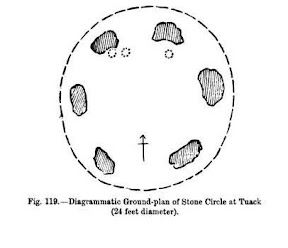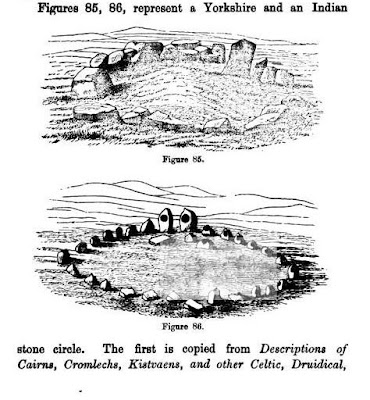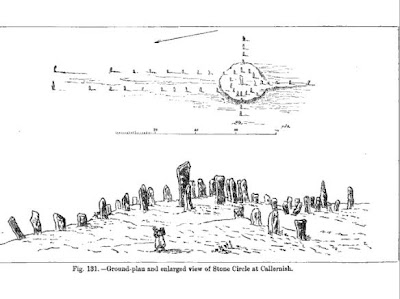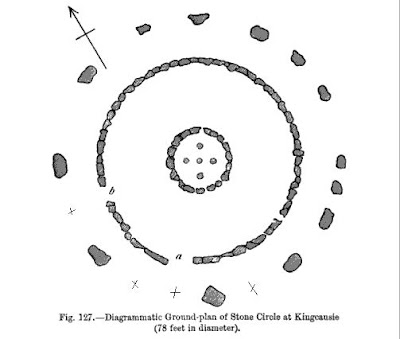It would not take long for him to see the co-relations between some of these events, like between days and months, between lunar months and seasons, between year and seasons, and between seasons and sun rises and sets in spring and autumn equinoxes, and, in summer and winter solstices.
He would be gazing stars and imagine some cluster of stars based on his surrounding animals and give them some zodiac names, e.g. Leo, Taurus, etc. He would align the sun rises and sun sets, and also the moon rises and moon sets, to these imaginary cluster of stars, and see a co-relation repeating over time. So he would expect, to his yet incomplete self tutored mind, the sun rises in all Summer Solstices in the constellation of Taurus in May,and so on. To count these passing events, he would need to mark their passages and track them and project the next events that would follow. This knowledge would be valued to the early men who lived under constant fear of the elements of nature and yet had not mastered it to the extent the modern man has.
What else would be so convenient than to pick the stones and use them as markers for the passing events, by having a "rotating" marker stone be moved around to different "stationary" events stones marking a particular event? He would start with a simple counting and marking mechanism, and as he would spend time doing this exercise, he would soon master the basic math, where a larger number X would be a repetition of some smaller number Y for some number Z times. He would use this knowledge of factorisation to conserve his stone to mark and track multiple time events, and their co relation, without wasting many stones in a complicated machine! The necessity is the mother of invention, and like a modern clock, he would device different circles with different number of stones, representing the same fundamental principle, except that the "motor" was him, the hand were the moving "marker" stones and the numbers were stationery "event" stones! He would show the use of underlying principle of overflow of a "digit", and skipping and not bothering with the left side "digit" till it has overflowed for the first time, as if counting from zero!
Being a man of practical wisdom, he would use the same place for burial and cremation, perhaps of some famous person, like family patriarch and community leader, and also for recording the time events he was observing. And the early man architect would use the same stones in his architecture to erect the temples for worship of his God, as per his understanding! The understanding was the underlying Male and Female principle of regeneration he would see in Sun and Earth respectively. Thus these stone rings became a place of marking nature's events, place of worship, a place of cremation/burial, commemoration of passing of some important personage, and also a social place of meeting and doing transactions! We slowly and surely pace ourselves through these progressions before we finally conclude our grand finally with posting on Stonehenge!


The picture above shows 6 Stones and 1 stone at the center. One could use this to count the 6 seasons which many ancients like Hindoos had, e.g., Vasant (Spring), Grishm (Summer), Varsha (Monsoon), Sharad (Autumn), Hemant (Mild Winter) and Shishu (Intense Winter) Ritus (Seasons). Being a modern man, who is used to computers, satellites, atomic clocks, telescopes, we would find this observation rather silly. But we must place ourselves in the shoes of the primitive man, perhaps going back as far 6000 BC to 3000 BC, which some of the stones in Stonehenge have been dated to.

The picture above shows 7 stones, with 2 missing but with marked places, and 2 to mark the "entrance" and 1 to mark the "alignment", adding them to 12 stones. Please note the number 7 and 12 before we jump to any conclusion. He could cycle the 7 stones for days in a week, perhaps keeping the previous week placed marker stone and adding a new one when passing the same day of the week! And he would have a different color stone for the month, and after 28 days, and 2 days, which he could use the 2 "entrance stones", he would move to the next "month" stone. Like modern engineers, he would revise his techniques after learning from his past mistakes and newer ideas to solve the discovered problems!

The above Stone Ring in Deccan, Southern India, has 28 stones, including the 2 "entrance" stones. Please note this is the number of days in a lunar month, when it is considered that the solar year was 360 days. Please read the Background in Astrology and Religion. All "dotted" stones are easy to identify.

The above "below" Stone Ring in India, has 28 stones, including the 2 "entrance stones". Also, the above "above" Stone Ring in Yorkshire, if some imagination is used to fill up the gaps with missing stones, and count the stones were the "edges" are visible, and not counting the "giant center" stone but imagining 2 stones behind, one can come to 28 stones, or a number close to it.

The plan can only be used to count the stones in the inner circle. There is one stone in the center and there are 12 stone making the inner circle. The center stone is the symbol of the Sun or Male Principle and the Circle is the symbol of the Earth or Mother Principle.

The stone circle in Amravati, in India, has around 28, 30 or 31 stones, if one counts all "demarcations" making 1 stone, filling in gaps and following the equidistant rule but allowing the builder a chance to fit big or small stones, but compensating for the increase or decrease in dimension by fitting smaller or bigger stone later on.

Stone ring in "Figure 14", has 21 rings in outer circle and 7 stones in inner circle, adding up to 28 stones, and perhaps the "moving" marker stone moves to the inner circle in the last week of the lunar month! Stone ring in "Figure 13" has approx 28 to 30 stones, if one accounts for smaller stones splitting but trying to keep the imaginary size in mind, yet accounting for some reasonable margin for the builder to adjust the sizes, but on average keeping them same. In "Figure 12" we have 12 Big Stones, and 2 Small Entrance Stones, not counting much smaller and incomparable stones used as filler for the gaps, one can imagine the building either keeping the small stone as a "separating stone" for excluding counting or counting as 13 stone when fitting lunar months into solar years!

In Fig 79, one accounts for last two stones on each side in the rear as making the edges, and counting them as a rectangle of stones made of 8 x 6, we come to 28 stones!

The inner circle has 19 to 20 stones, if one accounts for the 3 small stones with clear marking of edges like big stones. 19 is the Metonic Cycle and 20 is a factor of 60 and 360. If one counts the middle circle, one comes to 60 stones, if we just count the right side semi circle having 30 stones and double it. The outer most stone is difficult to count and strangely, if one just counts the stone marked in unequal distances, with missing gaps, there are 12 of them, which is a strange coincidence! It is difficult to extrapolate the "missing locations" because the gaps are many, but if one tries to put imaginary stones in equidistant, in line with the closest distance already demonstrated with other stones present, one comes to 24 stones! And then there are 4 stones in the center for the cardinal signs and 1 central stone. Strangely, if one moves the "marker" stone around 60 stones in the middle circle, and then moves the second "marker" stone from "imaginary 0" to 1, and then repeats the process for second marker at 2, 3, 4, for "from 1 to 2", "from 2 to 3", "from 3 to 4" and "from 5 to 6" transitions, and at central marked place one comes to 6 cycles of 60 counts, which is 360! The 5 are "overflow" stones for 60 turns of 5 overflows and for without overflow we have a one 60 turn! It is like counting from 0, or before the overflow event happens, we do not write the left most digit, so saving an instance of tracking or writing a "o" digit on left!
This may just look like a surprising coincidence, repeating at many sites, or a consistent oversight of many artists, or my wild imagination in counting them, is any one's guess, but most probably, knowing that the discovery must have been made by our early ancestors, and the evidence of stone circles being aligned with sun rising and sun setting events at solar solstices and equinoxes, it is reasonable to assume that these stone circles were also man's first attempt to clock the days, weeks, months and years and also predict the lunar or solar eclipses!
Now in next posting, we conclude if the same principle repeats in Stonehenge.
